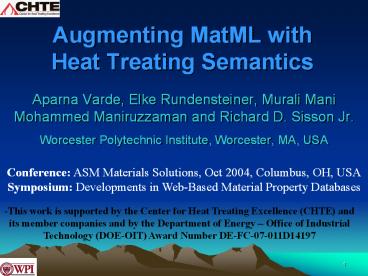Augmenting MatML with Heat Treating Semantics PowerPoint PPT Presentation
Title: Augmenting MatML with Heat Treating Semantics
1
Augmenting MatML with Heat Treating Semantics
- Aparna Varde, Elke Rundensteiner, Murali Mani
- Mohammed Maniruzzaman and Richard D. Sisson Jr.
- Worcester Polytechnic Institute, Worcester, MA,
USA
Conference ASM Materials Solutions, Oct 2004,
Columbus, OH, USA Symposium Developments in
Web-Based Material Property Databases
- This work is supported by the Center for Heat
Treating Excellence (CHTE) and its member
companies and by the Department of Energy
Office of Industrial Technology (DOE-OIT) Award
Number DE-FC-07-011D14197
2
Introduction
- Domain Specific Markup Language
- Medium of communication for domain users.
- Follows XML syntax.
- Encompasses domain semantics.
- MatML
- Materials Science Markup Language.
- XML for Materials Property Data.
- Developed by NIST (National Institute of Stds.
Technology). - Need for Extension
- MatML tags generic to Materials Science.
- Desirable to incorporate the semantics of Heat
Treating. - Extension proposed to MatML.
3
Heat Treating
- Involves controlled heating cooling of
materials to achieve desired mechanical
thermal properties. - Quenching or rapid cooling important step in
heat treating. - Quenchant cooling medium.
- Part material being cooled.
- Conditions Temperature, Agitation etc.
Quenching Setup at CHTE, WPI
4
MatML Materials Science Markup Language
- One common exchange format for Materials data.
- Standard developed by NIST.
- Follows XML syntax.
- Enhances interpretability of data.
- Allows extensibility.
5
MatML Structure
ltMatML_docgt ltMaterialgt
ltBulkDetailsgt lt/BulkDetailsgt
ltComponentDetailsgt ...
lt/ComponentDetailsgt . .
. . lt/Materialgt lt/MatML_docgt
- Root of schema
- MatML_Doc.
- Has one or more instances
- of Material element.
- Each has the foll. elements
- with sub-elements attributes.
- Bulk Details
- Component Details
- Metadata
- Graphs
- Glossary
6
Data Storage using MatML
- Tags describe entities in Materials Science.
- Nesting describes relationships between
entities. - Semantics of data represented.
- Generic to Materials Science domain.
7
Motivation for Extension
- Entities in Quenching Process.
- Quenchant, Part Surface, Quenching Conditions.
- These have attributes or properties.
- e.g. Viscosity is an attribute of Quenchant.
- MatML schema not sufficient to store data on
these. - Hence the need to capture the semantics of Heat
Treating / Quenching through extension.
8
Issues in Extending Domain Specific Markup
Languages
- Representing domain semantics Data models.
- Identifying needs of potential users Domain
expert interviews. - Ontological considerations E.g., synonyms.
- Designing the schema XML constraints etc.
- Revising the schema Based on critical reviews.
9
Modeling based on Semantics
10
Interviews Needs identified
- Some data in quenching has to be stored in
conjunction with basic materials information. - Example Consider a part undergoing quenching.
- Material properties of part, e.g., Component
Details. - Quenching process parameters, e.g., Part Surface.
- Hence the proposal for a Quenching element to
be part of a MatML document, at the same level as
the Material element. - Note Storage efficiency is the reason for
extending MatML rather than developing a new
QuenchML.
11
Ontology determined after Interviews
- Components of the ontology
- Quenching the process of rapid cooling.
- Quenchant cooling medium (oil, water, gas etc.)
- PartSurface material undergoing rapid cooling.
- Manufacturing details such as stamping and
welding. - QuenchConditions agitation, temperature etc.
- Results e.g., cooling rate, distortion, heat
transfer coefficient. - Graphs cooling curves, cooling rate curves, heat
transfer curves. - Synonyms
- Several terms mean the same, e.g., Part, Probe,
Work-piece all refer to one entity. Design
ontology accordingly.
12
Schema High Level Tag Set
13
Schema Placement of Element
- Within MatML_Doc
- in MatML schema.
- Same level as the
- Materials element.
- This enables cross-referencing between
Quenching and Material elements.
14
Schema Interpretability of Data
- Understanding meaning of stored data
- With reference to context,
- Without other documentation.
- Domain experts input crucial
- To decide how they want users to interpret data.
- Examples
- Cooling Rate stored specifically at different
locations. - Cooling Uniformity general inference about the
experiment. - Quenchant, part and conditions details should be
stored before the results and graphs.
15
Detailed Schema Partial Snapshot
16
XML Schema Constraints
- Sequence constraint to declare a list of
elements in order, e.g., - ltxsdelement nameQuenchinggt
- ltxsdcomplexTypegt
- ltxsdsequencegt
- .
- ltxsdelement nameQuenchConditionsgt ..
lt/xsdelementgt - ltxsdelement nameResults/gt ..
lt/xsdelementgt - lt/xsdsequencegt
- lt/xsdcomplexTypegt
- lt/xsdelementgt
- Disjunction constraint to declare mutually
exclusive elements, e.g., - ltxsdelement nameManufacturinggt
- ltxsdcomplexTypegt
- ltxsdchoicegt
- ltxsdelement refCasting/gt
17
XML Schema Constraints (Contd.)
- Key constraint to declare a primary key on an
element or attribute, i.e., it must have unique
values cannot have null values, e.g., - ltxsdelement nameQuenchantgt
- ltxsdcomplexTypegt
- ltxsdattribute name id type xsdID use
required/gt - .
- lt/xsdcomplexTypegt
- lt/xsdelementgt
- Occurrence constraint to declare the minimum and
maximum occurrences of an element. , e.g., - ltxsdelement nameCooling Rate minOccurs8
maxOccursunboundedgt - ..
- lt/xsdelementgt
- ltxsdelement nameGraphs minOccurs0
maxOccurs3gt - ..
- lt/xsdelementgt
18
XQuery for Retrieval of Data
- Schema designed to facilitate retrieval using
XQuery. - Issues
- XQuery is case-sensitive. Encourage users to
store data in a case-sensitive manner to ensure
correct retrieval. - Introduce additional tags if needed to assist
querying and provide good readability, by
anticipating typical user queries. - ltQuenchantgt
- ltNameDetailsgt
- ltManufacturergt lt/Manufacturergt
- ltTypegt
- ltSubtypegt lt/Subtypegt
- lt/Typegt
- lt/NameDetailsgt
- ltPropertyDetailsgt .. lt/PropertyDetailsgt
- lt/Quenchantgt
19
Conclusions
- Quenching Element proposed at CHTE as an
extension to MatML, the Materials Science Markup
Language (developed by NIST). - Ontology and schema developed. Schema revision
ongoing based on discussions with domain experts
and standards bodies (NIST). - Issues in extending domain-specific markup
languages considered. More issues may emerge. - Propose to incorporate this as a standard within
the original MatML, to include Heat Treating
semantics. - Useful application of XML in the Heat Treating
domain.

